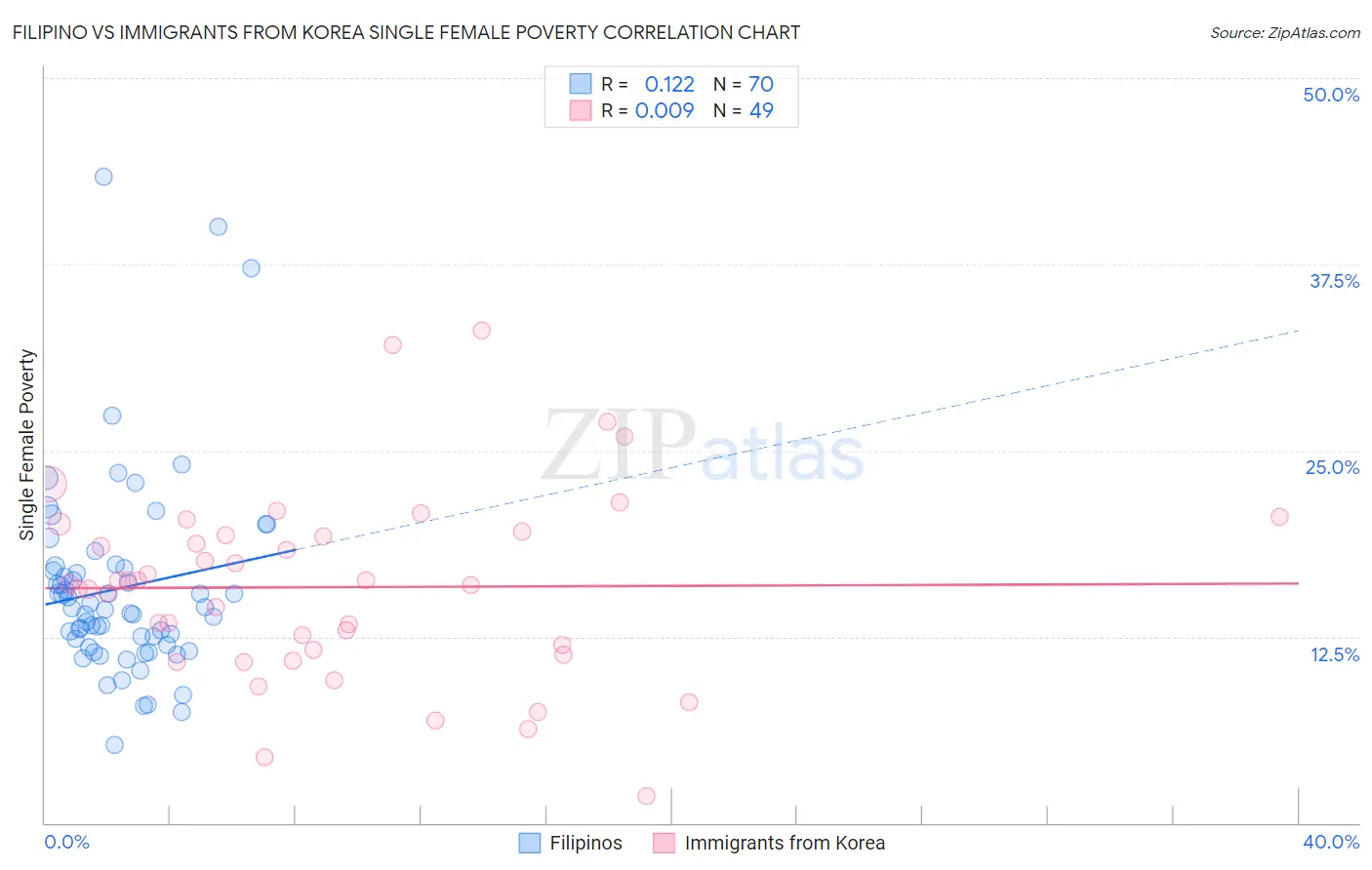Filipino vs Immigrants from Korea Single Female Poverty
COMPARE
Filipino
Immigrants from Korea
Single Female Poverty
Single Female Poverty Comparison
Filipinos
Immigrants from Korea
17.0%
SINGLE FEMALE POVERTY
100.0/ 100
METRIC RATING
6th/ 347
METRIC RANK
18.1%
SINGLE FEMALE POVERTY
100.0/ 100
METRIC RATING
17th/ 347
METRIC RANK
Filipino vs Immigrants from Korea Single Female Poverty Correlation Chart
The statistical analysis conducted on geographies consisting of 251,336,668 people shows a poor positive correlation between the proportion of Filipinos and poverty level among single females in the United States with a correlation coefficient (R) of 0.122 and weighted average of 17.0%. Similarly, the statistical analysis conducted on geographies consisting of 408,307,529 people shows no correlation between the proportion of Immigrants from Korea and poverty level among single females in the United States with a correlation coefficient (R) of 0.009 and weighted average of 18.1%, a difference of 6.5%.

Single Female Poverty Correlation Summary
| Measurement | Filipino | Immigrants from Korea |
| Minimum | 5.2% | 1.8% |
| Maximum | 43.4% | 33.0% |
| Range | 38.2% | 31.2% |
| Mean | 15.8% | 15.8% |
| Median | 14.3% | 16.1% |
| Interquartile 25% (IQ1) | 12.0% | 11.4% |
| Interquartile 75% (IQ3) | 17.1% | 19.4% |
| Interquartile Range (IQR) | 5.1% | 8.0% |
| Standard Deviation (Sample) | 6.7% | 6.3% |
| Standard Deviation (Population) | 6.7% | 6.3% |
Demographics Similar to Filipinos and Immigrants from Korea by Single Female Poverty
In terms of single female poverty, the demographic groups most similar to Filipinos are Assyrian/Chaldean/Syriac (17.0%, a difference of 0.20%), Immigrants from India (16.8%, a difference of 1.0%), Thai (17.3%, a difference of 1.7%), Immigrants from Iran (17.5%, a difference of 2.8%), and Immigrants from Hong Kong (16.5%, a difference of 2.8%). Similarly, the demographic groups most similar to Immigrants from Korea are Immigrants from Eastern Asia (18.1%, a difference of 0.28%), Immigrants from China (18.1%, a difference of 0.32%), Iranian (18.0%, a difference of 0.60%), Indian (Asian) (17.9%, a difference of 0.76%), and Bolivian (17.9%, a difference of 0.90%).
| Demographics | Rating | Rank | Single Female Poverty |
| Chinese | 100.0 /100 | #1 | Exceptional 16.1% |
| Immigrants | Taiwan | 100.0 /100 | #2 | Exceptional 16.4% |
| Immigrants | Hong Kong | 100.0 /100 | #3 | Exceptional 16.5% |
| Immigrants | India | 100.0 /100 | #4 | Exceptional 16.8% |
| Assyrians/Chaldeans/Syriacs | 100.0 /100 | #5 | Exceptional 17.0% |
| Filipinos | 100.0 /100 | #6 | Exceptional 17.0% |
| Thais | 100.0 /100 | #7 | Exceptional 17.3% |
| Immigrants | Iran | 100.0 /100 | #8 | Exceptional 17.5% |
| Bhutanese | 100.0 /100 | #9 | Exceptional 17.7% |
| Immigrants | Ireland | 100.0 /100 | #10 | Exceptional 17.8% |
| Immigrants | Lithuania | 100.0 /100 | #11 | Exceptional 17.8% |
| Immigrants | South Central Asia | 100.0 /100 | #12 | Exceptional 17.8% |
| Immigrants | Bolivia | 100.0 /100 | #13 | Exceptional 17.8% |
| Bolivians | 100.0 /100 | #14 | Exceptional 17.9% |
| Indians (Asian) | 100.0 /100 | #15 | Exceptional 17.9% |
| Iranians | 100.0 /100 | #16 | Exceptional 18.0% |
| Immigrants | Korea | 100.0 /100 | #17 | Exceptional 18.1% |
| Immigrants | Eastern Asia | 100.0 /100 | #18 | Exceptional 18.1% |
| Immigrants | China | 100.0 /100 | #19 | Exceptional 18.1% |
| Immigrants | Greece | 100.0 /100 | #20 | Exceptional 18.3% |
| Maltese | 100.0 /100 | #21 | Exceptional 18.3% |